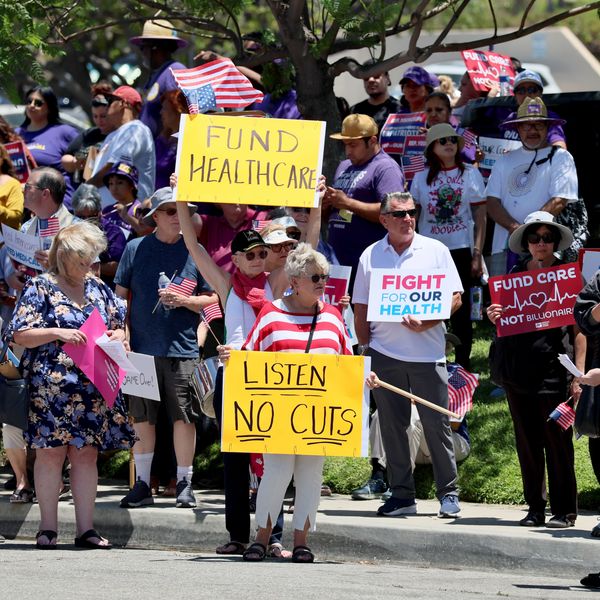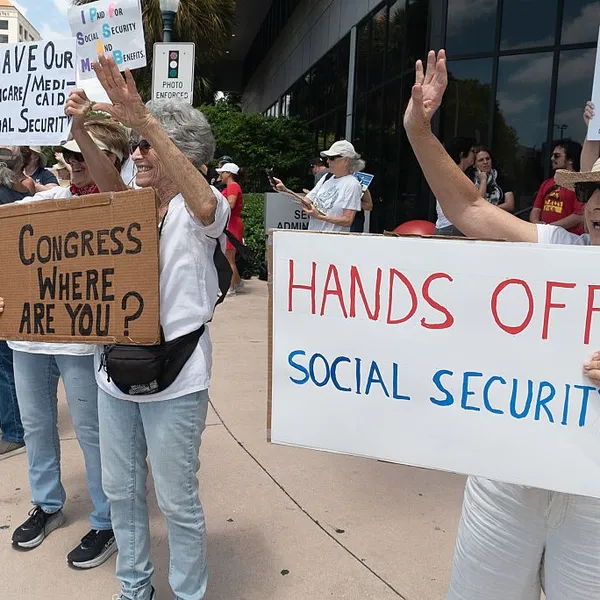You Really Want to Privatize Social Security in THIS Market?
The enduring mystery about President George W. Bush's old plan to privatize Social Security by moving contributions into individual savings accounts is how it survived two market crashes and decades of underperformance by workers' 401(k) accounts.
The enduring mystery about President George W. Bush's old plan to privatize Social Security by moving contributions into individual savings accounts is how it survived two market crashes and decades of underperformance by workers' 401(k) accounts.
This isn't a game-show fantasy....Whoever earns at least the minimum wage can become a millionaire in 45 years.
- Social Security privatization guru Sam Beard, during the stock market boom of the 1990s.Yet this idea still walks among us, like a zombie. As Bryce Covert of ThinkProgress observed Monday, it's been hawked by several of today's aspirants to the Republican nomination for President, including George W.'s brother Jeb, Sen. Ted Cruz (R-Tex.), Sen. Rand Paul, (R-Ky.), and Mike Huckabee and Rick Perry.
One would think no one needs more evidence to understand why privatizing Social Security is a terrible idea and well-nigh unworkable, but the recent convulsions in the stock market provide the opportunity for a refresher.
We pointed out earlier Monday that one day's market action--or even a week's--doesn't tell us much about the long-term direction of stocks, but that's true chiefly for investors in it for the long term. Retirees and near-retirees don't always have the luxury of a distant horizon. For someone planning to retire in the next month or year, the recent pullback of 10% can have direct and serious consequences.
The privatization idea was born during the go-go years of the 1980s and '90s, when everyone seemed to think that the bull market would go on forever. Individual workers, it was argued, could do a lot better over a 45-year working career by putting some or all of their 12.4% payroll tax into the stock market (counting their and their employers' contributions together) than the stodgy old Social Security Administration did by investing its surplus in Treasury bonds, its only legal investment. "This isn't a game-show fantasy," gushed Sam Beard, a leading promoter of Bush's privatization plan beginning in 2001. "Whoever earns at least the minimum wage can become a millionaire in 45 years."
This overlooked a few uncomfortable facts. One was that there was risk embedded in stocks' superior returns over bonds--and that risk was not evenly distributed. Privatization gurus noted that over the long run, stocks produced an annualized return of about 8%, which made them a great investment for anyone with a 45-year time horizon.
Continue reading here.
An Urgent Message From Our Co-Founder
Dear Common Dreams reader, The U.S. is on a fast track to authoritarianism like nothing I've ever seen. Meanwhile, corporate news outlets are utterly capitulating to Trump, twisting their coverage to avoid drawing his ire while lining up to stuff cash in his pockets. That's why I believe that Common Dreams is doing the best and most consequential reporting that we've ever done. Our small but mighty team is a progressive reporting powerhouse, covering the news every day that the corporate media never will. Our mission has always been simple: To inform. To inspire. And to ignite change for the common good. Now here's the key piece that I want all our readers to understand: None of this would be possible without your financial support. That's not just some fundraising cliche. It's the absolute and literal truth. We don't accept corporate advertising and never will. We don't have a paywall because we don't think people should be blocked from critical news based on their ability to pay. Everything we do is funded by the donations of readers like you. Will you donate now to help power the nonprofit, independent reporting of Common Dreams? Thank you for being a vital member of our community. Together, we can keep independent journalism alive when it’s needed most. - Craig Brown, Co-founder |
The enduring mystery about President George W. Bush's old plan to privatize Social Security by moving contributions into individual savings accounts is how it survived two market crashes and decades of underperformance by workers' 401(k) accounts.
This isn't a game-show fantasy....Whoever earns at least the minimum wage can become a millionaire in 45 years.
- Social Security privatization guru Sam Beard, during the stock market boom of the 1990s.Yet this idea still walks among us, like a zombie. As Bryce Covert of ThinkProgress observed Monday, it's been hawked by several of today's aspirants to the Republican nomination for President, including George W.'s brother Jeb, Sen. Ted Cruz (R-Tex.), Sen. Rand Paul, (R-Ky.), and Mike Huckabee and Rick Perry.
One would think no one needs more evidence to understand why privatizing Social Security is a terrible idea and well-nigh unworkable, but the recent convulsions in the stock market provide the opportunity for a refresher.
We pointed out earlier Monday that one day's market action--or even a week's--doesn't tell us much about the long-term direction of stocks, but that's true chiefly for investors in it for the long term. Retirees and near-retirees don't always have the luxury of a distant horizon. For someone planning to retire in the next month or year, the recent pullback of 10% can have direct and serious consequences.
The privatization idea was born during the go-go years of the 1980s and '90s, when everyone seemed to think that the bull market would go on forever. Individual workers, it was argued, could do a lot better over a 45-year working career by putting some or all of their 12.4% payroll tax into the stock market (counting their and their employers' contributions together) than the stodgy old Social Security Administration did by investing its surplus in Treasury bonds, its only legal investment. "This isn't a game-show fantasy," gushed Sam Beard, a leading promoter of Bush's privatization plan beginning in 2001. "Whoever earns at least the minimum wage can become a millionaire in 45 years."
This overlooked a few uncomfortable facts. One was that there was risk embedded in stocks' superior returns over bonds--and that risk was not evenly distributed. Privatization gurus noted that over the long run, stocks produced an annualized return of about 8%, which made them a great investment for anyone with a 45-year time horizon.
Continue reading here.
The enduring mystery about President George W. Bush's old plan to privatize Social Security by moving contributions into individual savings accounts is how it survived two market crashes and decades of underperformance by workers' 401(k) accounts.
This isn't a game-show fantasy....Whoever earns at least the minimum wage can become a millionaire in 45 years.
- Social Security privatization guru Sam Beard, during the stock market boom of the 1990s.Yet this idea still walks among us, like a zombie. As Bryce Covert of ThinkProgress observed Monday, it's been hawked by several of today's aspirants to the Republican nomination for President, including George W.'s brother Jeb, Sen. Ted Cruz (R-Tex.), Sen. Rand Paul, (R-Ky.), and Mike Huckabee and Rick Perry.
One would think no one needs more evidence to understand why privatizing Social Security is a terrible idea and well-nigh unworkable, but the recent convulsions in the stock market provide the opportunity for a refresher.
We pointed out earlier Monday that one day's market action--or even a week's--doesn't tell us much about the long-term direction of stocks, but that's true chiefly for investors in it for the long term. Retirees and near-retirees don't always have the luxury of a distant horizon. For someone planning to retire in the next month or year, the recent pullback of 10% can have direct and serious consequences.
The privatization idea was born during the go-go years of the 1980s and '90s, when everyone seemed to think that the bull market would go on forever. Individual workers, it was argued, could do a lot better over a 45-year working career by putting some or all of their 12.4% payroll tax into the stock market (counting their and their employers' contributions together) than the stodgy old Social Security Administration did by investing its surplus in Treasury bonds, its only legal investment. "This isn't a game-show fantasy," gushed Sam Beard, a leading promoter of Bush's privatization plan beginning in 2001. "Whoever earns at least the minimum wage can become a millionaire in 45 years."
This overlooked a few uncomfortable facts. One was that there was risk embedded in stocks' superior returns over bonds--and that risk was not evenly distributed. Privatization gurus noted that over the long run, stocks produced an annualized return of about 8%, which made them a great investment for anyone with a 45-year time horizon.
Continue reading here.


